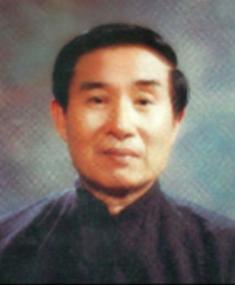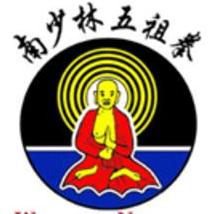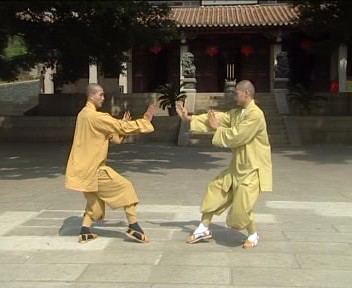SELECTION OF QUESTIONS AND ANSWERS
AUGUST 2011 PART 1

Grandmaster Chee Kim Thong
Question 1
You have mentioned learning Wuzuquan from Master Chee Kim Thong in at least 2 of your books, but you have never elaborated on the Wuzu style and how Master Chee taught you and your relationship with him.
— Chin, Malaysia
Answer
A main reason why I did not elaborate on Wuzuquan was because I felt my understanding and practice of Wuzuquan was not deep and not wide enough for me to do so, especially when there were many senior Wuzuquan practitioners who had learnt from Grandmaster Chee Kim Thong. This was a fact, and not merely mentioned out of modesty. Indeed, when one of my disciples, Andrew Barnett, the Chief Instructor of Shaolin Wahnam Switzerland, asked me to teach Wuzuquan so as to complete this part of our Shaolin Wahnam legacy, I told him precisely the same reason, i.e. I felt I was not good enough.
However, things change -- not that I suddenly become an expert in Wuzuquan, but I reason that as Wuzuquan is an integral part of my kungfu development and therefore constitutes an important part of our Shaolin Wahnam legacy, I have to do something to preserve it in our school. Hence, I hope to teach a course on Wuzuquan in the future.
To compensate for my inadequacy in Wuzuquan, compared with my sifu, Grandmaster Chee Kim Thong, I would spend much time to practice it as well as to research its philosophy from various sources. My understanding and practice in my other branches of Shaolin training help me a lot in this respect.
So in the Wuzuquan course, I shall present an introduction to Wuzuquan in a way as comprehensive as possible, covering all the four dimensions of kungfu training, namely philosophy, form, force training and combat application. It is hard to believe but true that students attending this course will attain (not just learn) in a few days what I myself could not attain even in a few years!
For example, I learned Abdominal Breathing during my Wuzuquan days, but even after a year I could not derive internal force from its practice. I practiced San Zhan for 2 years, but at that time if a Boxer were to throw fast jabs at me, or a Mixed Martial Art fighter were to charge at me with a shoot, I would be hit and pinned onto the ground helplessly. But, amongst many other benefits, students at the Wuzuquan course will have a taste of internal force from Abdominal Breathing, and be able to counter Boxers' jabs and MMA fighters' shoots.
I missed the opportunity of having Grandmaster Chee Kim Thong teach me directly. I learned Wuzuquan in Dungun, a coastal town by the South China Sea in Trengganu. Although Dungun was Grandmaster Chee Kim Thong's hometown, he spent most of his time in Kuala Lumpur. His eldest son, my Siheng Chee Boon Leong, taught us on his behalf.
As I did not have much personal contact with Grandmaster Chee Kim thong, unlike my other sifus, I do not have many stories to tell about him. But my siheng Chee Boon Leong was a good example of an internal art master for me to emulate. He was (and still is) kind, humble and soft-spoken, but tremendously powerful.
Question 2
Yes, Wuzuquan is descended from the Shaolin genre, but what are its key salient points that differentiates it from other Shaolin styles of Kungfu ?
Answer
For systematic discussion, we may consider the differences under four headings, namely philosophy, form, skills and application.
Wuzuquan originated as a Northern Shaolin style, formulated by a kungfu genius, Bai Yi Feng, at the northern Shaolin Temple in Henan during the Song Dynasty from five Shaolin styles, namely White Crane, Taizuquan, Lohanquan, Bodhidharma Style and Monkey Style.
However, over the years it became more Southern Shaolin in characteristics. This was mainly because Cai Yi Ming popularized it in Fujian of south China where Yong Chun White Crane was widely practiced. Hence, many Wuzuquan practitioners today are Fujianese speaking, and Wuzuquan is often known by its Fujian dialect of Goh Chor Kun.
This is an interesting salient point that differentiates it from all other Southern Shaolin styles. All other Southern Shaolin styles, like Hoong Ka, Wing Choon, Choy-Li-Fatt, Pak Mei, Dragon Style and White Crane originated from the southern Shaolin Temple. Wuzuquan is the only Southern Shaolin style (as it is now generally regarded) that originated from the northern Shaolin Temple.
Regarding form, a salient point about Wuzuquan that differentiates it from other Shaolin styles is profundity hidden in stark simplicity. Kungfu patterns of Southern Shaolin styles are quite elaborated. In Hoong Ka Kungfu, for example, there are dragon-hand, snake-fingers, tiger-claws, leopard-punch, and crane-beak.
But Wuzuquan patterns are bafflingly simple. In fact, when I first learned San Zhan, the fundamental set in Wuzuquan, I wondered how one could apply any San Zhan patterns against kicks, throws and qin-na (special ways of gripping). At first I thought San Zhan was only used for force training. It was only later when I studied it more deeply, I discovered that patterns from San Zhan could be used against any attack -- except if you are being pinned down on the ground.
Hence, San Zhan is complete by itself. In other words, by practicing only San Zhan, you can develop internal force and have enough fighting techniques to meet any attack. This is not so in most other Shaolin sets. In Choy-Li-Fatt, for example, you learn fighting techniques from kungfu sets, but hit sandbags or strike wooden man to develop force.
The Wuzuquan of Grandmaster Chee Kim Thong is famous for internal force. A salient point that differentiates it from other Shaolin styles is that its force is extremely soft, yet tremendously powerful. I clearly remember that my Siheng Chee Boon Leong, who taught us Wuzuquan on behalf of his father, Grandmaster Chee Kim Thong, constantly reminded us "mg mien yong lak" which is the Fujian dialect of saying "do not use strenght".
I wondered how one could fight effectively if he did not use strength. Earlier, when I learned Hoong Ka Kungfu from Uncle Righteousness, my sifu often told us "yong lek, yong lek", which is the Cantonese way of saying "use strength, use strength!" We hit a wooden man every night to develop force, and my arms were quite powerful. But when I sparred with my Wuzuquan classmates, my force was nowhere. Once my arms were so badly hurt that they had to be bandaged with medication for almost a week.
For combat application, Wuzuquan uses mainly strikes. Considering that it originated from Northern Shaolin where kicks were a forte, it is rather odd that kicks are not common in Wuzuquan. Felling and qin-na techniques are also few, and are hidden. This is a salient difference with other Shaolin styles. When viewing a performance of a typical Shaolin set, an informed observer can readily pick out felling and qin-na techniques in the set. But it is not so with Wuzuquan. When viewing a performance of San Zhan, for example, even Wuzuquan students of many years' experience may think there are no felling and qin-na techniques in the set. There are, but they are hidden from uninformed eyes.

The logo of Wuzuquan schools from Grandmaster Chee Kim Thong's lineage
Question 3
What are their training methods? How long did you study under Master Chee?
Answer
I trained in Grandmaster Chee Kim Thong's school for about two years, which was my shortest period in my training with all my four sifus.
My Wuzuquan training, like my training with Uncle Righteousness and Sifu Ho Fatt Nam in Shaolin but unlike my Wing Choon training with Sifu Choe Hoong Choy, was typically traditional. My Wing Choon training was privileged.
Traditional training was characterized by 5% learning and 95% practicing. Students normally did not know the meaning of what they were training, nor was there a time-frame to assess whether objectives had been realized. This was, and is, typical, of most kungfu schools.
Typically my Wuzuquan class taught by my Siheng Chee Boon Leong who started with stance training. This was followed by San Zhan solo practice, which took most of the training time. Then my Siheng or a senior would test our force in a San Zhan two-person practice. We concluded the class with sitting meditation. We did not use the usual lotus or half-lotus position, but what is known as the "Guan Yin pose". This went on for 2 years.
In contrast my Wing Choon training with Sifu Choe Hoong Choy was different. I chose the sets I wanted to learn, and he taught me behind closed doors in his clinic where I went for my traumatology (or kungfu medicine) training. (Sifu Choe Hoong Choy was also a very accomplished traumatologist.) Instead of taking a few months to learn a kungfu set, which most students do, it took me only 2 or 3 days.
It is interesting to compare the traditional method of teaching and learning kungfu used in most kungfu schools today with the method we use in Shaolin Wahnam. The keyword of the traditional method is "ku lian" or persistent practice, usually associated with sweet and toil.
Some practitioners seem to take pride in their long years of enduring, persistent practice, with statements like "It has taken me 20 years just to learn this set", implying that their art is so deep that it takes 20 years just to learn it. If they derive many benefits from their 20-year practice, that is fine, but if they are still weak and stressful, and cannot defend themselves even from simple attack, then they have wasted their time. Worse, they do not even have the mental clarity to realize it.
The keyword in our Shaolin Wahnam method is "attaining aims and objectives" We define our aims and objectives, practice according to proven methods, and assess our results within a given time-frame. We also make our practice itself fun. If we can achieve our purpose in 20 months, or even a few days, we do not want to practice for 20 years.
For example, in my planned Wuzuquan course in future our general aim is to have a comprehensive introduction to Wuzuquan in all the four dimensions of philosophy, form, internal force and combat application. In combat application, an objective is to apply Wuzuquan patterns against various forms of attack, including Boxing, Kick-Boxing, Muay Thai and Wrestling. We set only a few days to accomplish all these.
This does not mean we are going to neglect practice. We are very clear that in becoming a master, learning constitutes only 5% of the training time, 95% is practice. But we are going to set only a few days to have a comprehensive introduction to Wuzuquan according to our set aims and objectives. After the course, those who are interested to continue with Wuzuquan will set aside appropriate time according to their needs and aspirations for their practice.
Question 4
Since you named your school as Shaolin Wah-Nam after 2 of your Masters, is Master Chee in any way less in stature compared to your 2 main Masters, Master Lai Chin Wah and Master Ho Fatt Nam, or did you derive much less benefit from training Wuzuquan under Master Chee?
Answer
The reasons for my using the name "Shaolin Wahnam" were not as you suggested.
Using the term "Shaolin" was obvious, as I was teaching Shaolin arts. (Taijiquan was added later.)
Using "Wahnam" after my two sifus, Sifu Lai Chin Wah, who was more widely known as Uncle Righteousness, and Sifu Ho Fatt Nam was because the arts I taught came mainly from them. Had I taught arts mainly learnt from Sifu Chee Kim Thong and Sifu Choe Hoong Choy, which I didn't, I might have used "Thong Choy". The questions of whether Sifu Chee Kim Thong was of lesser statute, or whether I derived less benefit from his teaching, did not arise at all.
All my four sifus were patriarchs of their arts. This was no co-incident because except for my first sifu, Uncle Righteousness, I spent time searching for the best sifus. For meeting my first sifu, I would poetically describe as divine guidance.
Uncle Righteousness was a patriarch of Shaolin Kungfu, and as his nick-name clearly shows, was best known for his sense of righteousness and fighting ability. My second sifu, Sifu Chee Kim Thong, was a patriarch of Wuzuquan, and regarded as a living national treasure of the Peoples' Republic of China. My third sifu, Sifu Ho Fatt Nam, was the third successor from the southern Shaolin Temple at Quanzhou when it was burnt by the Qing Army. My fourth sifu, Sifu Choe Hoong Choy, was a patriarch of Choe Family Wing Choon Kungfu.
I derived a lot of benefits from the Wuzuquan of Sifu Chee Kim Thong which played a crucial part in the development of our school, Shaolin Wahnam, though at the time I was not aware of the benefits and their later significance. For example. a forte of Shaolin Wahnam is internal force. It was through the Wuzuquan of Sifu Chee Kim Thong that I had my first taste of internal force -- at the receiving end.
The phrase that had the deepest impression in me during my Wuzuquan training was "mg mian yong lak", which means "don't use strength" in the Fujian dialect. "Don't use strength and you will develop a lot of force" is a cardinal advice all internal force masters give regarding internal force training, an advice that certainly puzzles many people. It was in my Wuzuquan training that this advice came alive. Today in Shaolin Wahnam, this advice, now sounds as "relax, don't tense your muscles" is probably the most frequently mentioned in our teaching.

Two monks practicing Wuzuquan sparring
Question 5
I read an article that has bothered me so much about an inconclusive scientific finding that talks about certain physical traits such as the ratios between index fingers and middle fingers in gay man and straight man. Even though it is inconclusive, I happen to have the ratio that many gay man have. So now even this scientific study makes me so anxious.
— Tom, Holland
Answer
As you know that the finding was inconclusive, you should not be bothered with it.
Having similar ratio between index fingers and middle fingers as many gay men have does not indicate you are gay too. The similar ration may apply to other gropus of people, like artists or scholars.
Some research workers are notorious for selective evidence. They select evidence that suits their intention, and discard evidence that doesn't.
But suppose it were true that gay men had a specific ration between index and middle fingers, and you happened to have this ratio. Even with this presumption it does not show that you are gay. A person is gay when he willingly engages in gay activities and enjoys it. He does not become gay by thinking whether he is gay or normal, irrespective of his finger ration.
But such thinking is very harmful to him, and to you. It results in your identity problem. You have this problem because you did not have the mental clarity to see the reality, resulting in you forming a wrong perception. The reality is that you are normal, but you wrongly percieved yourself as having the possibility of being homosexual, or at best bisexual.
Now I have helped you to see clearly. You should now throw away your perverted perception, and overcome your identity problem.
Editorial Note
: Tom's other questions can be found in the
July 2011 Part 3
issue.
Question 6
I don't have anything against gay couples. I have met people of the same sex that seem to have loving relationships. I don't feel at all comfortable with it for myself, not because of a moral issue, but I don't want to feel an erotic passion for someone of the same sex. Yet I fear that I might be born with some of this potential, and I'm repressing it and this is not good.
Answer
Yours are very healthy normal attitudes which show you are not gay. But you persuaded yourself to perceive that you might be gay. Perception is often more important than reality.
I have personally seen many situations which were not serious at all but wrongly perceived by the persons involved to be so serious that they became matter of life and death to these people.
I have helped them to see reality and overcome their wrong perception. There were also experiments where sick persons were injected with just plain water but told to be the right medicine for their sickness. Because of positive perception the patients eventually got well.

Biological factors determine whether one is male or female, but cultural factors may have great influence in his or her feeling and behaviour
Question 7
I currently don't have a girlfriend, but in the past when I had one I enjoyed it and didn't think much of this issue because I guess my mind was busy with her.
But I want to solve this issue, so that I'm stronger for a true loving relationship. I don't want to be escaping from fears but clear them away, enjoy the peace within of understanding myself better.
Answer
Get a good girlfriend. The motive is not to use her to overcome your identity problem. Be kind and loving to her as a good boyfriend would. This is cultivating goodness. Goodness will always bring goodness. This will surely help you to overcome your identity problem, though it was the motive of having a girlfriend.
Question 8
I believe I like women more. I dream and fantasize with them, but since I don't experience with men, I sometimes fear what whether I am missing part of discovering who I am. My confusion has come to a point that I don't know now any more when a gay guy comes near if I am somewhat attracted to him.
Answer
Dreaming and fantasizing with women is a good healthy sign for young men like you. Go ahead and enjoy yourself wholesomely. Don't just fantasize but make it happen. Always be kind and loving to the women you have a good time with.
Fearing you may be missing something that is harmful is not only unnecessary but downight stupid. It is like saying you are now healthy but fear you may be missing the experience of being seriously sick, or you are now living comfortably in a civilized society but fear you may be missing the suffering of living in a famine-striken and war-torn country.
Don't be stupid. Don't indugle yourself in harmful thoughts and perverted views. Just throw these wrong perceptions away. If any of these wrong perceptions ever creep back just throw them away again without question and without fuss. Wake up and be grateful that you are blessed with so many good things.
You don't have to imagine a gay man coming near you, just as you don't have to imagine yourself to be seriously sick or in a famine-striken, war-torn country.
But what should you do if a gay man comes to you, which may actually happen. Very simple. Treat him with dignity as you would treat another human being, certainly not with trepedition or suspicion. Suppose he came very close to you or suggested gay activities with you. What should you do. Again, very simple. Just tell him politely that you are not his type. Gay people are actually very nice people. They won't harrass you. They would continue talking with you as normal friends, or leave you to look for willing partners.
Question 9
I have a little bit of fear that your views might be against homosexuality. I have met healthy and good people for whom being gay is just another feature of their personality and they are fine human beings. Their moral standards and other virtues are like anybody else. So many great authors and artists have been homosexual as well, so I don't feel comfortable saying its a bad thing to be gay. I don't want it for myself, but I'm not sure if one chooses it, or as modern science is saying, we are born with our sexuality.
Answer
I am not against homosexuals though I disapprove of homosexuality. As mentioned above, I believe homosexuals are generally very nice people.
My opinion is that homosexuality is culturally and not biologically caused. A person is born male or female according to his or her sexual organs and other biological factors that cause him or her to think, feel and act as a man or woman. If a man thinks, feels and acts like a woman, it is due to cultural influences.
However after a private discussion where a Shaolin Wahnam instructor told me cases of persons whose cultural environments were so against homosecuality yet they remained homosexuals, I have become more flexible in my views, and I am prepared to accept biological factors as the cause of some homosexuals. For example, a person may be born with a male body, but his biological factors produce so many female hormones that even without cultural influences he feels more comfortable to be a woman.
The heartening part is that regardless of whether a person's homosexuality was culturally or biologically caused, he can overcome it by practicing high-level chi kung. From the chi kung paradigm, homosexuality like any other disorder is a case of yin-yang disharmony, and is caused by energy blockage.
In the case of biologically caused homosexuality where persons in male bodies produce too many female homones that they behave as women, the blockage is physical. When the blockage is cleared by vigorous chi flow, their male bodies will produce the right amounts and types of homones resulting in them behaving as men.
In the case of culturally caused homosexuality where cultural factors that happened in their earlier years or even in their past lives cause men to behave like women, the blockage is emotional, mental or spiritual (i.e. in their consciousness). When vigorous chi flow has cleared the blockage, they will behave like men.
In your case, you are not even a homosexual. You only think you have a possibility to be one. The cause of your problem was mental. You were too confused to see reality, and you formed a wrong perception of your own sexuality. You do not even need high-level chi kung to clear your blockage. Once you have mental clarity to see your mistaken perception, as I have shown you in this e-mail, you will overcome your problem. But if you practice high-level chi kung, your success is even more assured. If you want to learn from us, please see our List of Certified Instructors or my website announceing my Intensive Chi Kung Course.
LINKS
Selected Reading
- Great Kungfu is a Progress of Spiritual Cultivation
- Zen is Zen, Tao is Tao
- Angry Bull Charges at Fence
- Tantui Combat-Application Sets
- What You Learn at the Intensive Chi Kung Course
